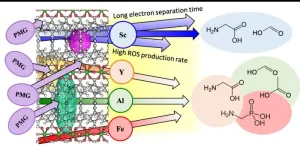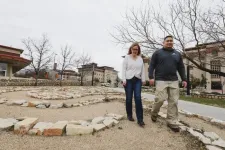(Press-News.org) Living in leafy areas near gardens, parks, and green spaces, may boost bone density and lower the risk of osteoporosis, finds research published online in the Annals of the Rheumatic Diseases.
Lower levels of air pollution in green spaces is a significant contributory factor to the associations found, conclude the researchers.
Osteoporosis weakens bones, making them fragile and prone to fracture. It can lead to chronic pain, diminished mobility, and poorer quality of life. Already a major health issue worldwide, its global prevalence is set to rise with the rapid ageing of the population and changes in lifestyle, note the researchers.
Osteoporosis is caused by genetic, hormonal and environmental factors, and while exposure to green spaces has been linked to lower risks of poor health, it’s not clear if this extends to the risk of osteoporosis, and to what extent genetic susceptibility might be influential.
To explore this further, the researchers analysed data held in the UK Biobank on 391,298 people, average age 56, just over half of whom (53%) were women.
All of them had information recorded on their bone mineral density, and potentially influential factors including ethnicity, annual household income, education level, employment status, residential area, alcohol consumption, physical activity levels, smoking status, and diet.
Their genetic risk of osteoporosis was calculated using a polygenic risk score, and a widely used measure, called a normalized difference vegetation index (NDVI), which is based on satellite imagery, was used to determine the amount of green space in their residential area.
The annual average exposures to the pollutants nitrogen oxide (NO2) and particulate matter PM2.5 were estimated based on residential postcode and data from the ESCAPE project, which is looking at the long-term effects on human health of exposure to air pollution in Europe.
Each participant was monitored until a diagnosis of osteoporosis, death, or 31 March 2021, whichever came first.
During an average monitoring period of 12 years, new cases of osteoporosis arose in 9307 people. They were more likely to be older, female, smokers, and retired. They were also more likely to have lower educational attainment and be more economically disadvantaged.
But a consistent association between the amount of green space and new cases of osteoporosis emerged. The authors estimated the NDVI in steps of about 300 metres of available residential greenness at a range of 300 to 1500 metres. With each such increase of the NDVI they found an increase in bone mineral density and 5% lower risk of developing osteoporosis.
The key moderating factors in the association found between green space and reduction of the risk to develop osteoporosis were lower levels of NO2 and PM2.5
Several studies have shown that exposure to air pollution can produce oxidative stress, inflammation, and disrupt hormones, both of which increase the risk of osteoporosis, note the researchers.
People living in the leafiest areas will be exposed to a lower risk because the trees and plants act as natural filters, removing pollutants from the air.
Being physically active was also associated with a lower risk of osteoporosis, possibly because living in areas with green space affords more opportunities to exercise, suggest the researchers.
This is an observational study, and as such, can’t establish cause. The researchers also acknowledge several limitations, including that the NDVI calculation was based on residential addresses so may not have accurately defined the actual amount of green space. And the study participants were generally healthy, so the potential for selection bias can’t be discounted.
But they nevertheless conclude: “The findings from this study present the first evidence indicating that residential greenness is associated with higher bone density and decreased risk of developing osteoporosis.”
They add: “These findings provide valuable insights into the potential of greenness in preventing the onset of osteoporosis and emphasise the significance of urban greening in developing effective prevention strategies.”
END
Living in “leafy” areas may boost bone density and lower osteoporosis risk
Lower air pollution in areas with green spaces significant contributory factor
2024-03-06
ELSE PRESS RELEASES FROM THIS DATE:
Taking 9000 to 10000 steps daily may counteract the risk of death and cardiovascular disease in highly sedentary people
2024-03-06
Every additional step up to around 10,000 steps per day reduces the risk of death and cardiovascular disease (CVD), regardless of how much remaining time is spent sedentary, reports a large population-based study published online in the British Journal of Sports Medicine.
Some previous studies have shown that greater daily step counts are associated with lower levels of death and CVD, while others have linked high levels of sedentary behaviour with increased risks of CVD and death. However, none of these studies investigated whether high levels of physical activity may offset or lessen the higher risk of death and CVD ...
Even low levels of leisure time physical activity help to lower stroke risk
2024-03-06
Even people whose physical activity levels fall short of recommended guidelines, but who manage to do some during their leisure time, are likely to have a lower risk of stroke than their sedentary peers, suggests a pooled data analysis of the available evidence, published online in the Journal of Neurology Neurosurgery & Psychiatry.
The effects are independent of age and sex, the findings show, prompting the authors to suggest that everyone should be encouraged to do whatever level of physical activity they can manage in their leisure time.
There’s no doubt that ...
Daily step count of 9,000 to 10,000 may counteract risk of death and cardiovascular disease in highly sedentary people
2024-03-06
In good news for office workers, a new study from the University of Sydney’s Charles Perkins Centre (Australia) has found increasing your step count may counteract the health consequences of too much sedentary time each day.
The study of over 72,000 people, published in the British Journal of Sports Medicine, found every additional step up to around 10,000 steps a day was linked to reduced risk of death (39 percent) and cardiovascular disease (21 percent) regardless of how much remaining time was spent sedentary.
Previous studies have shown an association between greater daily step count and lower levels ...
Novel device for stomach complaints has successful human trial
2024-03-06
The endoscopic mapping device, developed over more than a decade by scientists at the Auckland Bioengineering Institute, consists of an inflatable sphere covered in sensors, delivered down the oesophagus and able to measure electrical activity in the gut.
In the same way abnormal heart electrical signals can cause serious heart problems, so research has found faulty bioelectric gut waves can lead to stomach pain, nausea, vomiting and bloating.
But often doctors can’t find out what the problem is. ...
Oregon State researchers make key advance toward removing pesticide from groundwater
2024-03-06
CORVALLIS, Ore. – Scientists led by an Oregon State University chemistry researcher are closing in on a new tool for tackling the global problem of weedkiller-tainted groundwater.
Kyriakos Stylianou of the OSU College of Science led an international team that identified a material known as a metal-organic framework, or MOF, that showed an ability to completely remove, and also break down, the oft-used herbicide glyphosate.
The MOF, one of four tested in a collaboration among scientists from Oregon State and Tiangong University in China, is based on scandium, chemical symbol Sc, ...
UTEP clinical trial to encourage healthy walking habits
2024-03-06
EL PASO, Texas (March 5, 2024) – Health researchers at The University of Texas at El Paso are launching a clinical trial to improve walking in the El Paso community, thanks to a $4.4 million grant from the National Institutes of Health (NIH). The project will enroll local school district employees in 50K 4 Life, a program that challenges them to improve their health by walking at least 50,000 steps per week.
“This is an exciting opportunity to improve our community’s health through the simple, free and life-changing ...
Research explores the cooling effects of ‘scuba-diving’ in lizards
2024-03-06
BINGHAMTON, N.Y. -- Anoles are the scuba-diving champions of the lizard world, able to stay underwater for more than 16 minutes. For animals whose body temperature depends on the environment, time spent in a cool running stream can have some tradeoffs, according to new research from Binghamton University, State University of New York.
A recent study by Binghamton University doctoral candidate Alexandra M. Martin, Christopher K. Boccia of Queens University in Canada, and Binghamton University Assistant Research Professor of Biological Sciences Lindsey ...
Gender gap on Wikipedia
2024-03-05
Since it was created in 2001, Wikipedia has become a key element of the modern public sphere, which has revolutionized the way we create and share information. However, it has defects when it comes to its decentralization and flexibility, specially regarding inclusion and diversity.
Some gender biases that stand out are shown in its content and its editorial participation. It has a low percentage of women’s biographies and an unequal representation in editing. Also, there are gaps in the gender representation regarding its content, biases in editing and participation, as well as imbalances in readership.
These ...
Scientists to study real-world eating behaviors using wearable sensors and artificial intelligence
2024-03-05
A pedometer measures your steps, but what if you had a similar automated device to measure your eating behavior? Evidence from nutritional studies has long shown that the speed, timing and duration of an individual’s eating behavior are strongly related to obesity and other health issues. While eating behaviors can be accurately measured in a controlled laboratory setting, a blind spot exists when researchers attempt to study how participants actually eat “in the wild.”
A new National Institutes ...
Radioguided surgery accurately detects and removes metastatic lymph nodes in newly diagnosed prostate cancer patients
2024-03-05
Reston, VA — Radioguided surgery can detect and remove metastatic pelvic lymph nodes in patients newly diagnosed with prostate cancer, according to research published in the March issue of The Journal of Nuclear Medicine. Targeting the prostate-specific membrane antigen (PSMA), which is overexpressed in most prostate cancer patients, radioguided surgery can improve nodal staging to guide treatment recommendations for this important patient population.
In newly diagnosed prostate cancer patients, nodal involvement correlates with recurrence, and determining if lymph node metastases are present and where they ...
LAST 30 PRESS RELEASES:
Mount Sinai Health system receives $8.5 million NIH grant renewal to advance research on long-term outcomes in children with congenital heart disease
Researchers develop treatment for advanced prostate cancer that could eliminate severe side effects
Keck Medicine of USC names Christian Pass chief financial officer
Inflatable fabric robotic arm picks apples
MD Anderson and SOPHiA GENETICS announce strategic collaboration to accelerate AI-driven precision oncology
Oil residues can travel over 5,000 miles on ocean debris, study finds
Korea University researchers discover that cholesterol-lowering drug can overcome chemotherapy resistance in triple-negative breast cancer
Ushikuvirus: A newly discovered giant virus may offer clues to the origin of life
Boosting the cell’s own cleanup
Movement matters: Light activity led to better survival in diabetes, heart, kidney disease
Method developed to identify best treatment combinations for glioblastoma based on unique cellular targets
Self-guided behavioral app helps children with epilepsy sleep earlier
Higher consumption of food preservatives is associated with an increased risk of type 2 diabetes
NTU Singapore-led team captures first-ever ‘twitch’ of the eye’s night-vision cells as they detect light, paving the way for earlier detection of blindness-causing diseases
Global aviation emissions could be halved through maximising efficiency gains, new study shows
Fewer layovers, better-connected airports, more firm growth
Exposure to natural light improves metabolic health
As we age, immune cells protect the spinal cord
New expert guidance urges caution before surgery for patients with treatment-resistant constipation
Solar hydrogen can now be produced efficiently without the scarce metal platinum
Sleeping in on weekends may help boost teens’ mental health
Study: Teens use cellphones for an hour a day at school
After more than two years of war, Palestinian children are hungry, denied education and “like the living dead”
The untold story of life with Prader-Willi syndrome - according to the siblings who live it
How the parasite that ‘gave up sex’ found more hosts – and why its victory won’t last
When is it time to jump? The boiling frog problem of AI use in physics education
Twitter data reveals partisan divide in understanding why pollen season's getting worse
AI is quick but risky for updating old software
Revolutionizing biosecurity: new multi-omics framework to transform invasive species management
From ancient herb to modern medicine: new review unveils the multi-targeted healing potential of Borago officinalis
[Press-News.org] Living in “leafy” areas may boost bone density and lower osteoporosis riskLower air pollution in areas with green spaces significant contributory factor




